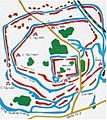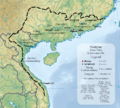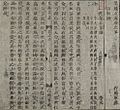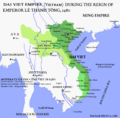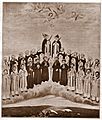History of Vietnam facts for kids
The history of Vietnam started about 2,700 years ago. For a long time, from 207 BC until 938 AD, powerful Chinese empires ruled Vietnam directly. But in 938 AD, Vietnam bravely fought for and won its independence.
Even after gaining independence, Vietnam often paid tribute to its much larger neighbor, China. This was a way to keep peace and avoid conflicts. Vietnam also successfully fought off invasions from the Chinese and even three attacks by the powerful Mongols between 1255 and 1285.
Vietnam's independence ended for a while in the mid-1800s when France took control and made it a colony. This period is known as French Indochina. During World War II, Japan took over Vietnam from the French. After the war, France tried to rule Vietnam again, but they lost the First Indochina War.
In 1954, the Geneva Accords decided to split Vietnam into two parts: North Vietnam and South Vietnam. The plan was to hold elections later to reunite the country. However, instead of peaceful reunification, this split led to the terrible Vietnam War. During this war, China and the Soviet Union supported North Vietnam, while the United States supported South Vietnam.
Millions of Vietnamese people died in the war. It finally ended in April 1975 when the North took over Saigon, the capital of the South. Vietnam was then reunified under one government. After the war, Vietnam faced challenges and was isolated from many other countries. But in 1986, the Communist Party of Vietnam started new economic policies. Since then, Vietnam has seen a lot of economic growth.
Contents
Early Kingdoms and Myths
The earliest signs of an organized society in northern Vietnam, after the Iron Age Đông Sơn culture, were found in Cổ Loa. This ancient city is close to what is now Hanoi.
According to old Vietnamese myths, the first Vietnamese people came from a special union. Their ancestors were the Dragon Lord Lạc Long Quân and the Immortal Fairy Âu Cơ. They had 100 sons! Later, they decided to go their separate ways. Fifty sons went with their mother to the mountains, and the other fifty went with their father to the sea.
The oldest son became the first in a line of early Vietnamese kings. These kings were known as the Hùng kings (Hùng Vương or the Hồng Bàng Dynasty). The Hùng kings named their country Văn Lang. It was located in the Red River delta in what is now northern Vietnam. The people of Văn Lang were called the Lạc Việt.
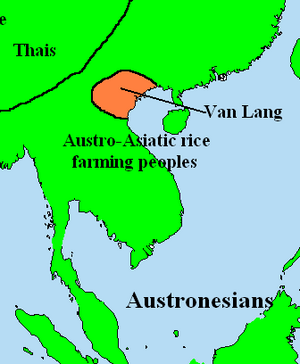
Chinese Rule and Independence
After the Hùng kings, Vietnam was ruled by different Chinese dynasties for over a thousand years. This long period of Chinese rule greatly influenced Vietnamese culture, government, and writing.
However, the Vietnamese people never gave up their desire for independence. They often rebelled against Chinese rule. Finally, in 938 AD, Vietnam won a major battle and gained its independence from China. This was a very important moment in Vietnamese history.
Even after becoming independent, Vietnam still had to deal with its powerful neighbor, China. Sometimes, Vietnam would pay tribute to China to keep the peace. This meant sending gifts or money to show respect, but it didn't mean Vietnam was no longer independent.
Fighting for Freedom
Vietnam had to fight many battles to protect its independence. Besides the Chinese, they also faced invasions from the fierce Mongols. The Mongols were a huge empire that conquered many lands. But Vietnam successfully fought off three Mongol invasions between 1255 and 1285. This showed how strong and determined the Vietnamese people were.
Later, in the 19th century, Vietnam faced a new challenge: European powers. France began to take control of Vietnam, making it a colony. This was a difficult time for Vietnam, as the French ruled the country for many decades.
Modern Vietnam
During World War II, Japan took control of Vietnam from the French. After the war, France tried to regain its power, but the Vietnamese fought back in the First Indochina War. Vietnam won this war, and the French had to leave.
However, Vietnam was then divided into North and South. This led to the Vietnam War, a long and difficult conflict. The war ended in 1975 when Vietnam was reunified under one government.
Since the 1980s, Vietnam has focused on rebuilding and growing its economy. Today, Vietnam is a developing country with a rich history and a bright future.
Images for kids
-
Proposed neolithic migration paths into Southeast Asia, with Austronesian peoples from the sea and Austroasiatic peoples from inland Mekong.
-
Pottery fruit tray of the Sa Huỳnh people.
-
Southern China and the Baiyue , c. 200 BC.
-
Nanyue at its greatest extent
-
Northern Vietnam under Eastern Jin Dynasty 382 AD.
-
Vietnam under the Chinese Tang Dynasty
-
One Pillar Pagoda built by Lý Thái Tông in 1049
-
Edict on the Transfer of the Capital, written by emperor Lý Công Uẩn
-
The territory of Đại Việt during the reign of Lê Thánh Tông (1460–1497), including conquests in Muang Phuan and Champa.
-
From 1533 until 1592, Vietnam was divided between the northern Mac dynasty and the southern Le dynasty.
-
Many Catholic martyrs (believers and priests) were slain in Tonkin and Cochinchina during persecutions. 64 Martyrs were declared blessed in 1900 of whom 54 were natives; 26 of the martyrs were members of the Dominican Order.
-
French gunships attacking Saigon
-
Nguyễn Ái Quốc, later known as Hồ Chí Minh, in France, 1921
-
Hồ Chí Minh (third from left, standing) with the OSS in 1945
-
Vietcong prisoners await being carried by helicopter to rear area after Operation Starlite. August 18–24, 1965.
See also
 In Spanish: Historia de Vietnam para niños
In Spanish: Historia de Vietnam para niños








